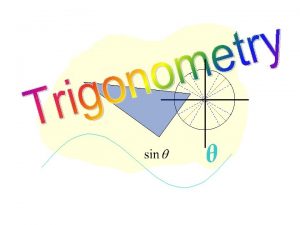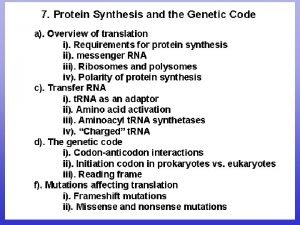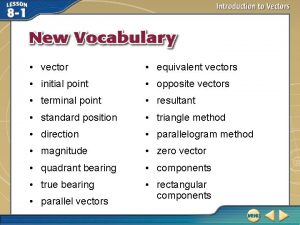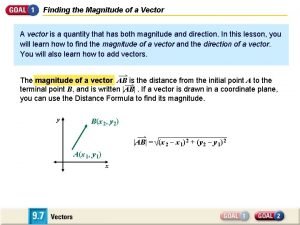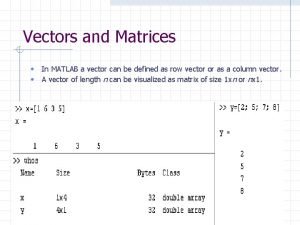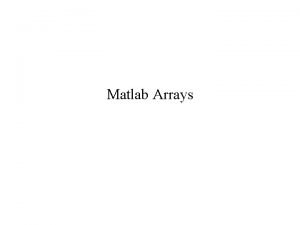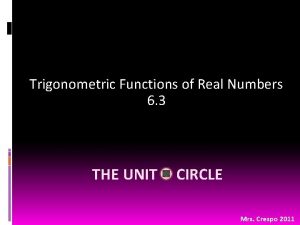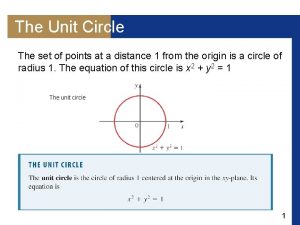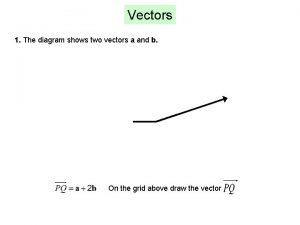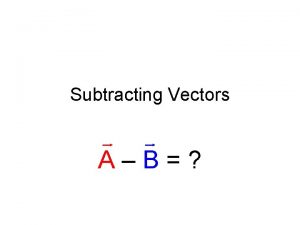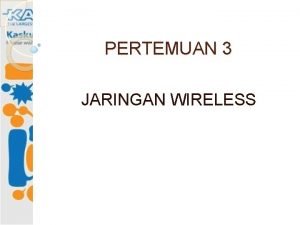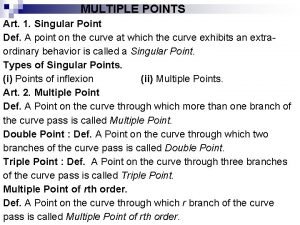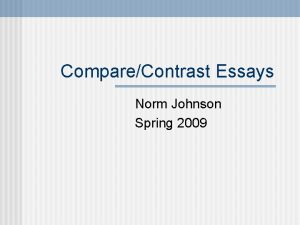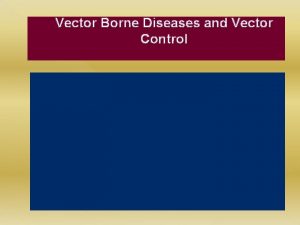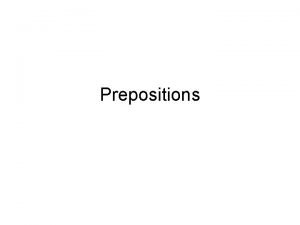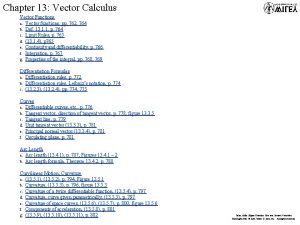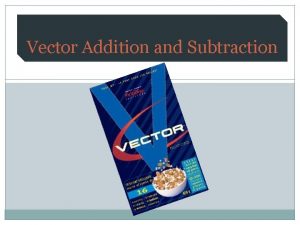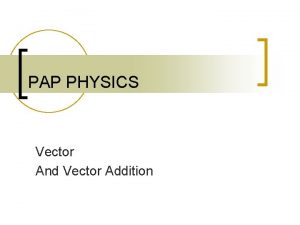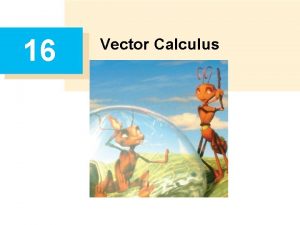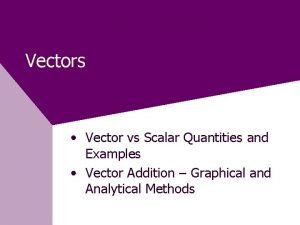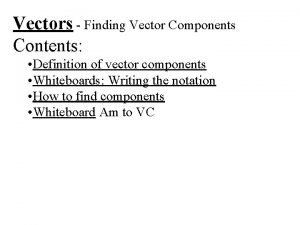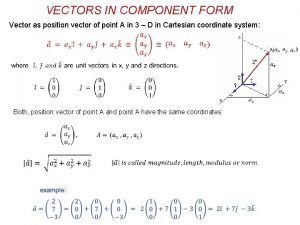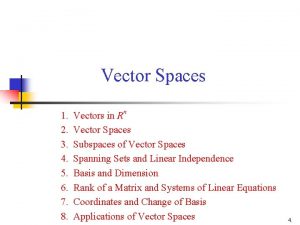vector equivalent vectors initial point opposite vectors terminal



































- Slides: 35

• vector • equivalent vectors • initial point • opposite vectors • terminal point • resultant • standard position • triangle method • direction • parallelogram method • magnitude • zero vector • quadrant bearing • components • true bearing • rectangular components • parallel vectors

• Utilizing your book, what is the difference between a scalar and a vector?

Identify Vector Quantities A. State whether a hockey puck shot northwest at 60 miles per hour is a vector quantity or a scalar quantity. This quantity has a magnitude of 60 miles per hour and a direction of northwest. This directed distance is a vector quantity. Answer: vector

Identify Vector Quantities B. State whether a tennis ball served at 110 miles per hour is a vector quantity or a scalar quantity. This quantity has a magnitude of 110 miles per hour, but no direction is given. Speed is a scalar quantity. Answer: scalar

Identify Vector Quantities C. State whether a sprinter running 100 meters north is a vector quantity or a scalar quantity. This quantity has a magnitude of 100 meters and a direction of north. This directed distance is a vector quantity. Answer: vector

State whether a tow truck pulling a car due east with a force of 100 newtons is a vector quantity or a scalar quantity. A. vector B. scalar

Represent a Vector Geometrically A. Use a ruler and a protractor to draw an arrow diagram for v = 10 newtons of force at 30° to the horizontal. Include a scale on the diagram. Using a scale of 1 cm : 5 N, draw and label a 10 ÷ 5 or 2 -cm arrow in standard position at a 30° angle to the x -axis. Sample Answer: V

Represent a Vector Geometrically B. Use a ruler and a protractor to draw an arrow diagram for z = 25 meters per second at a bearing of S 70°W. Include a scale on the diagram. Using a scale of 1 cm : 10 m/s, draw and label a 25 ÷ 10 or 2. 5 -cm arrow 70° west of south. Sample Answer:

Represent a Vector Geometrically C. Use a ruler and a protractor to draw an arrow diagram for t = 10 miles per hour at a bearing of 025°. Include a scale on the diagram. Using a scale of 1 cm : 10 mi/h, draw and label a 10 ÷ 10 or 1 -cm arrow at an angle of 25° clockwise from the north. Sample Answer:

Use a ruler and protractor to draw an arrow diagram for n = 20 feet per second at a bearing of 080°. Include a scale on the diagram. A. C. B. D.

• Video


Find the Resultant of Two Vectors HIKING While hiking in the woods, Shelly walks 2 kilometers N 30°W from her camp, and then walks 2 kilometers directly east. How far and at what quadrant bearing is Shelly from her camp? Let p = walking 2 kilometers N 30°W and q = walking 2 kilometers due east. Draw a diagram to represent p and q using a scale of 1 cm : 1 km.

Find the Resultant of Two Vectors Use a ruler and a protractor to draw a 2 -centimeter arrow 30° west of north to represent p and a 2 -centimeter arrow due east to represent q.

Find the Resultant of Two Vectors Method 1 Triangle Method Translate q so that its tail touches the tip of p. Then draw the resultant vector p + q as shown.

Find the Resultant of Two Vectors Method 2 Parallelogram Method Translate q so that its tail touches the tail of p. Then complete the parallelogram and draw the diagonal, resultant p + q, as shown.

Find the Resultant of Two Vectors Both methods produce the same resultant vector p + q. Measure the length of p + q and then measure the angle this vector makes with the north-south line as shown. The vector’s length of 2 centimeters represents 2 kilometers. Therefore, Shelly is 2 kilometers at a bearing of 30° east of north or N 30°E from her starting position.

Find the Resultant of Two Vectors Answer: 2 km, N 30°E

ORIENTEERING In an orienteering competition, Miguel walks N 80 E for 150 feet and then walks 200 feet due east. How far and at what quadrant bearing is Miguel from his starting position? A. about 349 feet at a bearing of N 86°E B. about 270 feet at a bearing of N 37°E C. about 270 feet at a bearing of N 47°E D. about 350 feet at a bearing of N 80°E


Operations with Vectors Draw a vector diagram of a – 3 b. Rewrite the expression as the addition of two vectors: a – 3 b = a + (– 3 b). To represent – 3 b, draw a vector 3 times as long as b in the opposite direction from b.

Operations with Vectors Then use the triangle method to draw the resultant vector. Answer:

Draw a vector diagram of n + 2 m. A. C. B. D.

Use Vectors to Solve Navigation Problems AVIATION An airplane is flying with an airspeed of 475 miles per hour on a heading of 070°. If an 80 mile-per-hour wind is blowing from a true heading of 120°, determine the velocity and direction of the plane relative to the ground. Step 1 Draw a diagram to represent the heading and wind velocities.

Use Vectors to Solve Navigation Problems Translate the wind vector as shown in the diagram below, and use the triangle method to obtain the resultant vector representing the plane’s ground velocity and direction g. In the triangle formed by these vectors, γ = 120° – 70° or 50°.

Use Vectors to Solve Navigation Problems Step 2 Use the Law of Cosines to find |g|, the plane’s speed relative to the ground. c 2 = a 2 + b 2 – 2 ab cos γ Law of Cosines |g|2 = 80 2 + 4752 – 2(80)(475) cos 50° c = |g|, a = 80, b = 475, and γ = 50° Take the positive square root of each side.

Use Vectors to Solve Navigation Problems ≈ 428. 0 Simplify. The ground speed of the plane is about 428. 0 miles per hour. Step 3 The heading of the resultant g is represented by angle θ, as shown above. To find θ, first calculate α using the Law of Sines c = |g| or 428. 0, a = 80, and γ = 50

Use Vectors to Solve Navigation Problems Solve for sin α. Apply the inverse sine function. Simplify. The measure of θ is 70° – α, which is 70° – 8. 2° or 61. 8°. Therefore, the speed of the plane relative to the ground is about 428. 0 miles per hour at about 061. 8°.

Use Vectors to Solve Navigation Problems Answer: The velocity of the plane relative to the ground is about 428. 0 miles per hour at a bearing of about 061. 8°.

ROWING Jamie rows her boat due east at a speed of 20 feet per second across a river directly toward the opposite bank. At the same time, the current of the river is carrying her due south at a rate of 4 feet per second. Find Jamie’s speed and direction relative to the shore. A. Jamie is rowing at a resultant velocity of 24 ft/s in a direction directly east. B. Jamie is rowing at a resultant velocity of 20. 4 ft/s in a direction of S 11. 3°E. C. Jamie is rowing at a resultant velocity of 20. 4 ft/s in a direction of S 29. 8°E. D. Jamie is rowing at a resultant velocity of 20. 4 ft/s in a direction of S 78. 7°E.

Resolve a Force into Rectangular Components A. GARDENING While digging in his garden, Will pushes a shovel into the ground with a force of 630 newtons at an angle of 70° with the ground. Draw a diagram that shows the resolution of the force that Will exerts into its rectangular components.

Resolve a Force into Rectangular Components Will’s push can be resolved into a horizontal push x forward and a vertical push y downward as shown. Answer:

Resolve a Force into Rectangular Components B. GARDENING While digging in his garden, Will pushes a shovel into the ground with a force of 630 newtons at an angle of 70° with the ground. Find the magnitudes of the horizontal and vertical components of the force. The horizontal and vertical components of the force form a right triangle. Use the sine or cosine ratios to find the magnitude of each force.

Resolve a Force into Rectangular Components Right triangle definitions of cosine and sine Solve for x and y. Use a calculator. Answer: horizontal component ≈ 215. 47 N; vertical component ≈ 592. 01 N

SOCCER A player kicks a soccer ball so that it leaves the ground with a velocity of 39 feet per second at an angle of 37° with the ground. Find the magnitude of the horizontal and vertical components of the velocity. A. horizontal component ≈ 28. 75 ft/s; vertical component ≈ 23. 28 ft/s B. horizontal component ≈ 37 ft/s; vertical component ≈ 39 ft/s C. horizontal component ≈ 31. 15 ft/s; vertical component ≈ 23. 47 ft/s D. horizontal component ≈ 23. 47 ft/s; vertical component ≈ 31. 15 ft/s
 Resolution of vectors
Resolution of vectors Terminal ray definition
Terminal ray definition טרנסלציה
טרנסלציה Terminal and non terminal in compiler design
Terminal and non terminal in compiler design Equivalent vectors
Equivalent vectors How to find the magnitude of a vector
How to find the magnitude of a vector Matlab vector of vectors
Matlab vector of vectors Matlab array initialize
Matlab array initialize Vector addition properties
Vector addition properties Vector unitario de un vector
Vector unitario de un vector Position vector symbol
Position vector symbol Trigonometric functions of real numbers
Trigonometric functions of real numbers How to find terminal points on the unit circle
How to find terminal points on the unit circle Trapezium vector
Trapezium vector The diagram shows two vectors that point west and north.
The diagram shows two vectors that point west and north. Wireless access point attack vector
Wireless access point attack vector Point by point block method
Point by point block method How to write compare and contrast essay
How to write compare and contrast essay Block arrangement essay
Block arrangement essay Hub and spoke airline
Hub and spoke airline What is point to point protocol
What is point to point protocol Point proof analysis
Point proof analysis Topologi infrastruktur
Topologi infrastruktur 2 point perspective box
2 point perspective box Node cusp and conjugate point
Node cusp and conjugate point A moving point to point in art
A moving point to point in art Flash point vs boiling point
Flash point vs boiling point Point by point block method
Point by point block method Point to point organization
Point to point organization Point by point block method
Point by point block method Point-by-point essay examples
Point-by-point essay examples Dew pressure calculation
Dew pressure calculation Points of parity and points of difference
Points of parity and points of difference Diagonal vanishing point
Diagonal vanishing point Fixed point representation
Fixed point representation Congruent vs incongruent melting
Congruent vs incongruent melting

